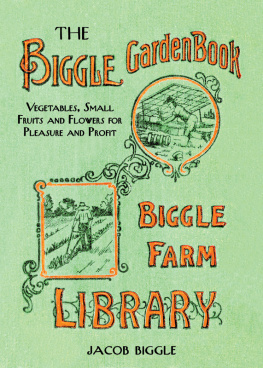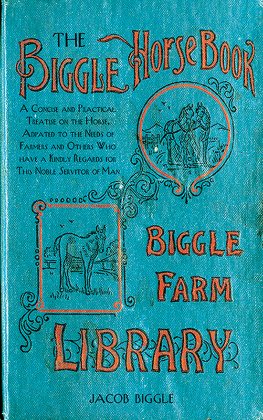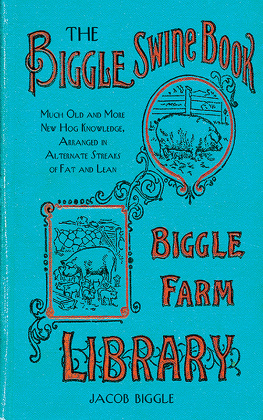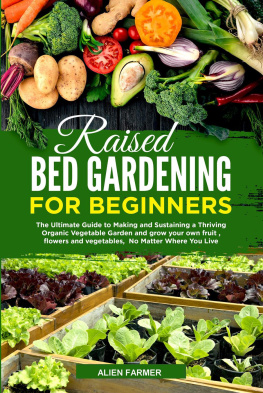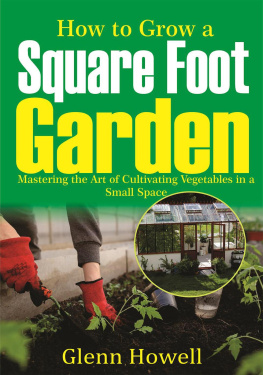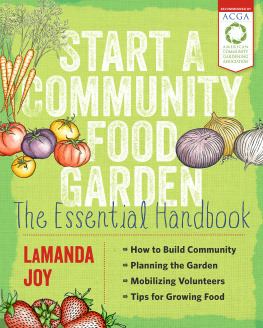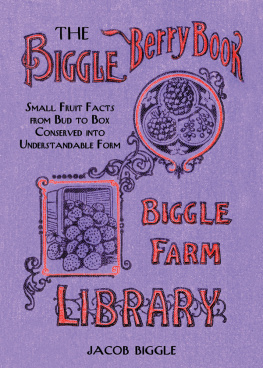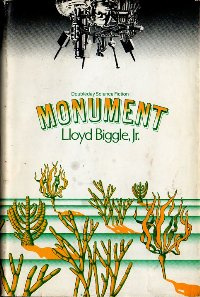
ONE DAYS GLEANINGS FROM A SMALL BACK-YARD GARDENSHOWING THAT INTENSIVE CULTURE CAN DO MUCH ON EVEN A SMALL SPACE

Copyright 2014 by Skyhorse Publishing
All Rights Reserved. No part of this book may be reproduced in any manner without the express written consent of the publisher, except in the case of brief excerpts in critical reviews or articles. All inquiries should be addressed to Skyhorse Publishing, 307 West 36th Street, 11th Floor, New York, NY 10018.
Skyhorse Publishing books may be purchased in bulk at special discounts for sales promotion, corporate gifts, fund-raising, or educational purposes. Special editions can also be created to specifications. For details, contact the Special Sales Department, Skyhorse Publishing, 307 West 36th Street, 11th Floor, New York, NY 10018 or info@skyhorsepublishing.com.
Skyhorse and Skyhorse Publishing are registered trademarks of Skyhorse Publishing, Inc., a Delaware corporation.
Visit our website at www.skyhorsepublishing.com.
10 9 8 7 6 5 4 3 2 1
eISBN: 978-1-62873-912-1
Library of Congress Cataloging-in-Publication Data is available on file.
ISBN: 978-1-62636-144-7
Printed in China
PREFACE
I N reality a preface is rather a queer thing, because its a foreword which is written last! So, it seems, I am now to have the last word. To begin, I feel especially indebted to R. L. Watts for several extracts from his excellent Pennsylvania Bulletin No. 147; to W. N. Hutt, author of Maryland Bulletin No. 116; and to the authors of various other bulletins, books and catalogs whose writings have given me occasional lifts over rough places. My thanks go also to the E. A. Strout Co., New York City, and to a few well-known implement manufacturers, who kindly loaned me several photographs. Most of the pictures in the book, however, were especially made for it by expert photographers and engravers who were carefully instructed regarding the practical details of each picture.
Now just a few hints about the final problem of the average gardenerthe selling end of the business: Dont ship to every strange commission house that solicits your consignment. Get a good solid house and stick to it. Or sell direct to storekeepers; or join or form a co-operative shipping and selling association; or work up a list of retail customers of your own. As an aid to the latter plan, the Long Island Agronomist, Huntington, N. Y., has evolved a shipping package which it calls a home hamper. It measures twenty-four inches long, fourteen inches wide, ten inches deep, and weighs about thirty pounds when filled. It contains six baskets holding about one-half peck each; these are filled with vegetables in season, from radishes to cauliflower. Assortment is made to furnish soup, salad and substantiate, with occasional fancies, such as eggplant and cantaloupes. Home hampers are packed in the morning, shipped by express at 7 A. M., and delivered at the customers door in time for dinner; hence real sweet corn, crisp lettuce, melting peas, beans, etc., all A No. 1, are available for the table of the city dweller. The average family uses two home hampers per week. Price, $1.50 each, delivered at the door, within the delivery limits of the Long Island Express Company and payable at the end of each month. Good idea, it seems to me. Try it.
Send only fresh, clean, attractive products to market; sort, grade and honestly pack and mark each package; give full measure; use only clean, neat packages, and put your name and brand thereon. Keep the culls for stock feed; earn a reputation for fancy products only.
My earnest wish: May your garden be a great success, whether planned for pleasure or profit.
Elmwood.
J ACOB B IGGLE .

CONTENTS

NEVER PLOW SOIL WHEN IT IS VERY WET AND STICKYWAIT UNTIL IT DRIES INTO CRUMBLY, WORKABLE CONDITION
C HAPTER I
PREPARATION OF THE LAND
It is well to aim high even when getting ready to plant things in the ground .Harriet.
T HE man, woman or youngster who really wants a garden, will somehow manage to have a good one regardless of soil conditions, bad weather, measles in the family, or whether the area of ground at hand is a square acre or a square rod. But, of course, if one has a chance to select the site and the soil, tis well to know what to choose.
L OCATION OF THE G ARDEN .If it is to be a family garden, designed primarily to furnish an all-season supply of fresh things for the home table, the location should be one handy to the house, but not handy to the hen-house.
If it is to be a truck garden, primarily for profit, nearness to a city or fair-sized town is an important point to consider. Why? Because market, manure and labor will then be within easy reach, and the gardener can more easily keep posted on market conditions. Long hauls are expensive; long-distance connections are not always satisfactory. If he can not locate within easy driving distance of such a place, then the next best thing is to choose a spot within easy reach of railway station or steamboat wharf, whereby quick transportation (preferably without transfers) may be had direct to a good market. And, in either case, let him beware of bad or hilly roads over which he must pass to reach market or transportation line. Hauling big loads up hill or through mud or over ruts and stones iswell, it isnt good business.
S LOPE , AND W IND P ROTECTION .I agree with R. L. Watts, when he says: For the production of early vegetables, the aspect or exposure is an important factor, Earlier truck can be produced on land with a southern or southeastern exposure. Locations not naturally protected by hills or woodland may be made warmer by the planting of hedges for windbreaks. The Norway spruce is excellent for this purpose. It is particularly important to have the coldframe and hotbed plat well protected from the north and west winds.
A S TO S OIL .Any soil, he states, which produces satisfactory crops of wheat, corn and oats, will generally give good results when planted with vegetables. Some vegetables, however, require special peculiarities of soil and do not thrive when planted in soils wanting in such properties. For example, it is impossible to grow first-class carrots, salsify, radishes and other vegetables with long roots, in a soil containing much clay. These and many other vegetables thrive best in sandy soils, while cabbage, cauliflower and sweet corn prefer heavier soils. Sandy soils produce the earliest and smoothest vegetables, and such soils are very easily tilled, yet they are extremely leachy and require liberal applications of manure to maintain productiveness. Distinctly gravelly soils, containing very little clay, should be avoided. Heavy, stiff tenacious clays are not desirable for any branch of gardening, although quite susceptible to permanent improvement. Reclaimed bogs and swamps are excellent, when properly handled, for the production of onions, celery, etc.
W. W. Rawson, in his well-known book on market gardening, says: Sandy loam, with a sandy or gravelly subsoil, should be selected. A clay subsoil, at least until underdrained, will render any land cold, as it retains the moisture.

